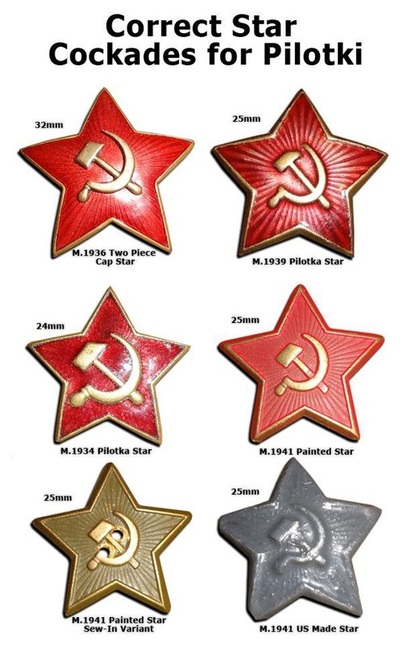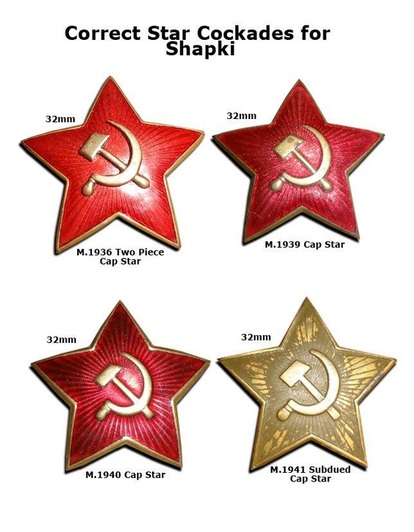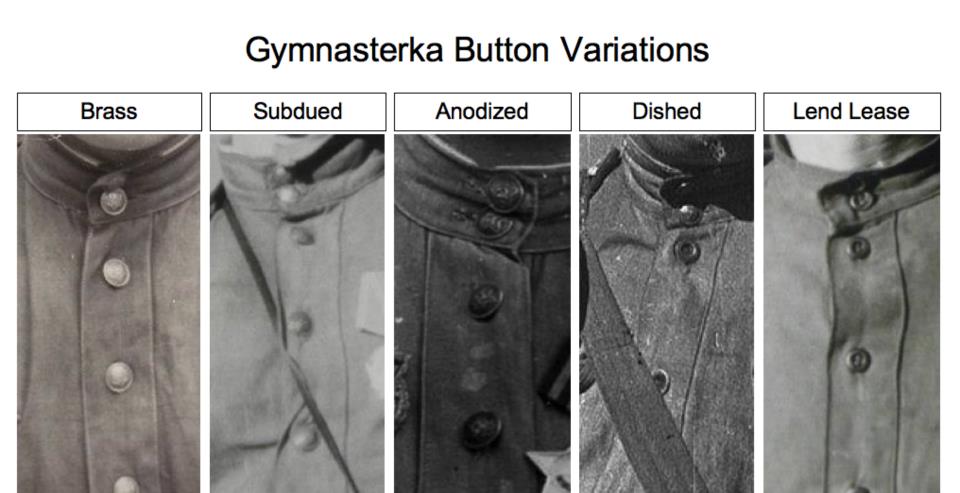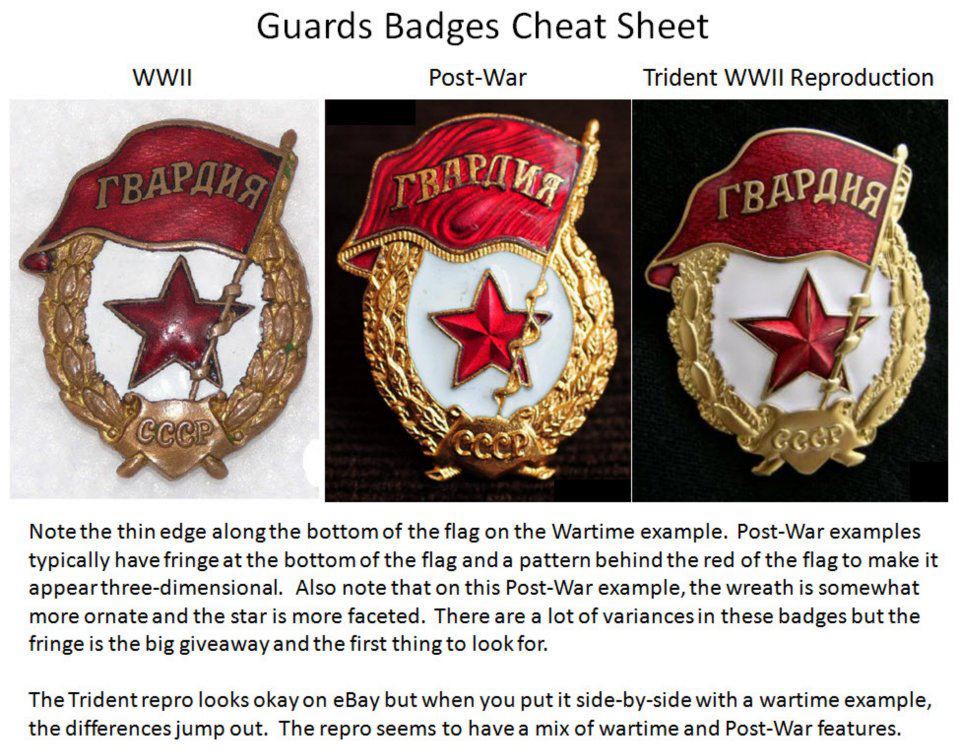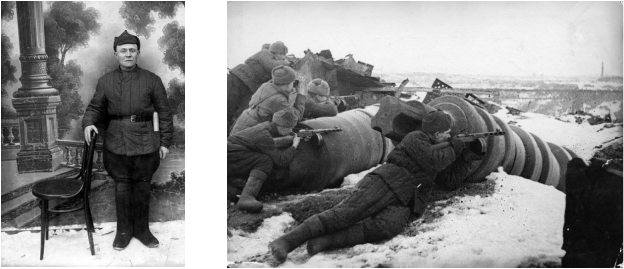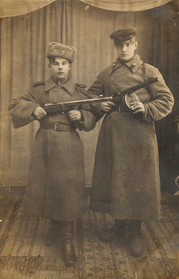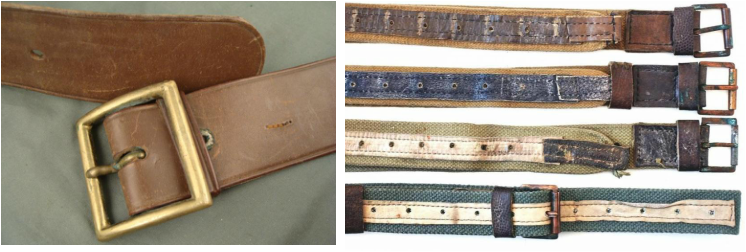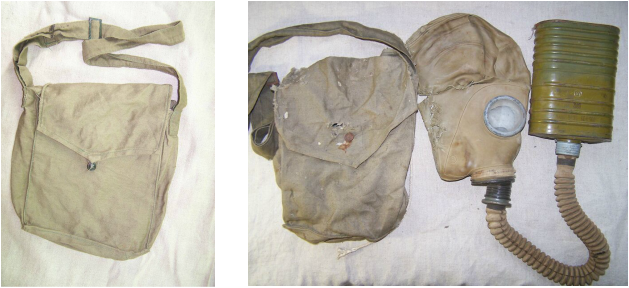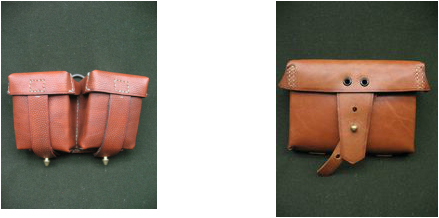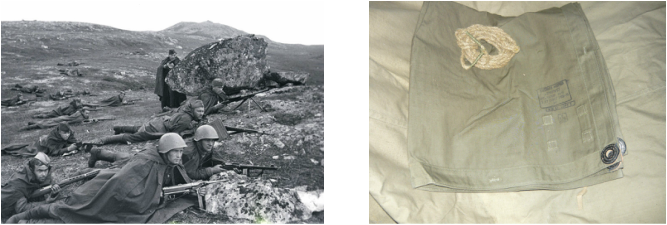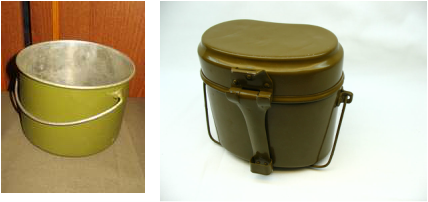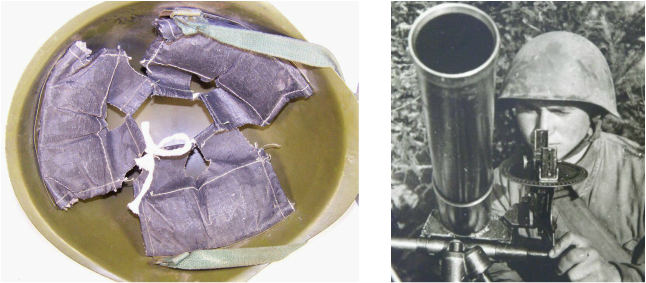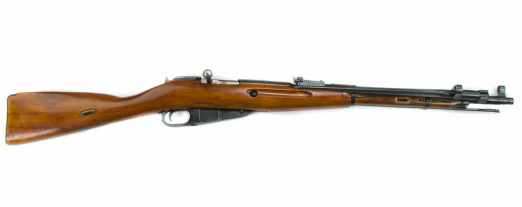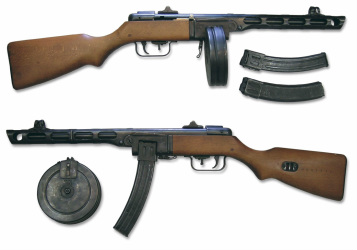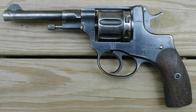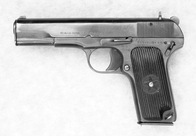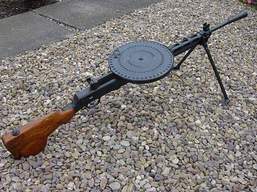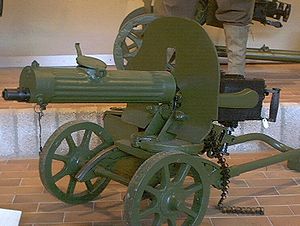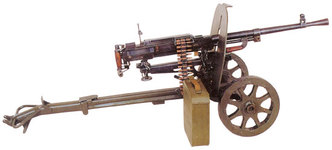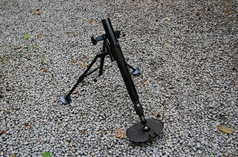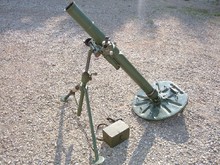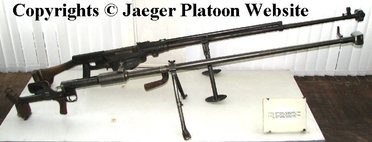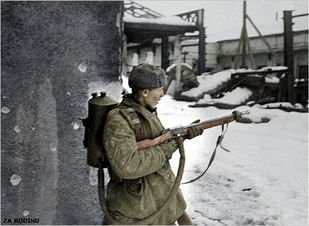WELCOME!
All members, recruits, and guests should be in good health, have a period-correct hairstyle, and wear period-style eye glasses or contacts to our events.
Below is a guide to help you when buying uniforms, gear etc. Remember, if you not sure not about an item, ask the command staff or CO to help you. This prevents you from wasting money on something you can not use.
DIAGRAM SHOWING THE RED ARMY SOLDIER IN FULL MARCHING KIT
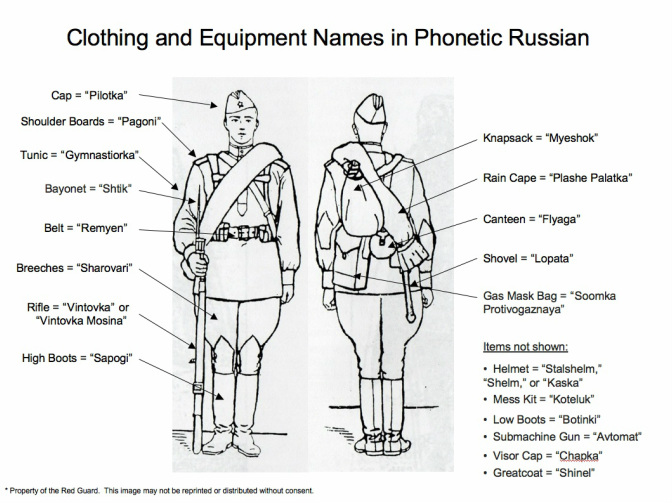
NOTE: The above diagram dates to immediately after the war. Only ONE ammo pouch should be worn (on your right hip) for mid and late war impressions. Two pouches are acceptable only for early war impressions.
TIPS FOR BUYING YOUR KIT:
1. Research - When most people get into the hobby, they want to start buying uniforms and equipment right away. Стой! There is a great deal of variety in the quality of goods available and it can get confusing fast. Something that may seem like a great deal, may not be usable. Before buying anything, do your research and ask questions.
2. Make a plan... - Some people make a budget and try to buy one item per month. Others decide to work from top to bottom or bottom to top. Whatever works for you, make a plan and stick with it.
3. But be flexible - The market for goods can be volatile so if something you need comes along, get it while you can. Surplus items can go from plentiful to scarce or scarce to plentiful quicker than you think.
4. Always buy the best you can - Price and delivery time are far less important than quality so save your money and buy the best. In the long run, you'll save money because the better stuff generally lasts longer.
5. Buy it once - Buying the right item once is always cheaper than the buying the wrong thing and having to replace it.
6. Don't borrow underwear - The first things you should buy are the things you don't want to borrow.
7. First things first - Buy the things you can't borrow first. Below is a list to help you prioritize your purchases.
First Priority:
Second Priority:
Third Priority:
Fourth Priority:
1. Research - When most people get into the hobby, they want to start buying uniforms and equipment right away. Стой! There is a great deal of variety in the quality of goods available and it can get confusing fast. Something that may seem like a great deal, may not be usable. Before buying anything, do your research and ask questions.
2. Make a plan... - Some people make a budget and try to buy one item per month. Others decide to work from top to bottom or bottom to top. Whatever works for you, make a plan and stick with it.
3. But be flexible - The market for goods can be volatile so if something you need comes along, get it while you can. Surplus items can go from plentiful to scarce or scarce to plentiful quicker than you think.
4. Always buy the best you can - Price and delivery time are far less important than quality so save your money and buy the best. In the long run, you'll save money because the better stuff generally lasts longer.
5. Buy it once - Buying the right item once is always cheaper than the buying the wrong thing and having to replace it.
6. Don't borrow underwear - The first things you should buy are the things you don't want to borrow.
7. First things first - Buy the things you can't borrow first. Below is a list to help you prioritize your purchases.
First Priority:
- Boots
- Underwear set including shirt, pants, and portyanki (or period socks)
- Mess kit, cup, and spoon
- M-43 tunic w/ shoulder boards and proper shoulder board buttons and Guards badge (original badge preferred.)
- M-43 breeches
- Pilotka with original star insignia
- Waist belt
- Weapon
Second Priority:
- Ammunition pouch
- Plashe rain cape/shelter half
- Myeshok rucksack
- Canteen
- SSh-40 Helmet
Third Priority:
- Basic "winter" uniform consisting of Ushanka fur cap, overcoat or padded jacket and padded pants
- Entrenching tool and cover
- Gas mask bag.
Fourth Priority:
- Personal items like ID books, period straight razors, lighters, pipes, etc...
- Early war items such as M-35 tunic, collar insignia, etc...
1. UNIFORMS
A. PILOTKA CAPS & PEAKED SERVICE CAPS -
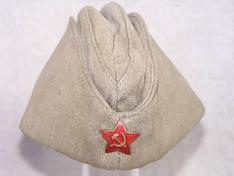
The pilotka is the standard headgear of the Red Army soldier. They are inexpensive and generally readily available. I would not pay more than $15 or so for a postwar pilotka. (Wartime-dated examples can go for as much as $300.) Enlisted pilotkas should be tan/brownish-green and made of cotton. Only officers may have branch of service piping on their pilotkas. Some postwar pilotkas are very green or made out of a cotton/poly blend material that has a pronounced sheen. Beware of these. Any regular pilotka made before 1975 or so should be fine. Check with the Kapitan if you're not sure. Collectrussia.com and eBay are good places to look.
All enlisted personnel are expected to have an original or early postwar red enamel or OD cap star on their pilotkas. Original and/or early postwar cap stars are very easy to spot due to their more rugged construction.
collectrussia.com and tridentmilitary.com have red enamel cap stars for $12, original from WW2. Visor/peaked caps are only for Officers or Sr. NCOs. They too must have an original cap star. The incorrect post war style of cap star will not be allowed under any circumstances.
Remember, when wearing your pilotka, wear it with a little flair. Tilt it to your right a bit over your right eye and pinch the front and rear of the cap like they did. The pilotka should also be worn under the SSh-40 helmet to help give the helmet a tighter more snug fit. This was a common wartime practice. Also, the side flaps may be turned down for warmth against mild cold. Be sure to put a needle and some thread inside one of your ear flaps or inside the cap like the frontoviks did.
Another note of interest; cap stars and other insignia was usually removed from penal units and you see many wartime photos with regular enlisted men with no cap insignia, perhaps fallen off, perhaps never issued on the cap to begin with. It also was not uncommon to see ushanka-sized capstars on pilotkas.
All enlisted personnel are expected to have an original or early postwar red enamel or OD cap star on their pilotkas. Original and/or early postwar cap stars are very easy to spot due to their more rugged construction.
collectrussia.com and tridentmilitary.com have red enamel cap stars for $12, original from WW2. Visor/peaked caps are only for Officers or Sr. NCOs. They too must have an original cap star. The incorrect post war style of cap star will not be allowed under any circumstances.
Remember, when wearing your pilotka, wear it with a little flair. Tilt it to your right a bit over your right eye and pinch the front and rear of the cap like they did. The pilotka should also be worn under the SSh-40 helmet to help give the helmet a tighter more snug fit. This was a common wartime practice. Also, the side flaps may be turned down for warmth against mild cold. Be sure to put a needle and some thread inside one of your ear flaps or inside the cap like the frontoviks did.
Another note of interest; cap stars and other insignia was usually removed from penal units and you see many wartime photos with regular enlisted men with no cap insignia, perhaps fallen off, perhaps never issued on the cap to begin with. It also was not uncommon to see ushanka-sized capstars on pilotkas.
The cap stars below were provided courtesy of Mr. Dakota Böttcher -
B. M-43 TUNIC (Gymnastiorka) -
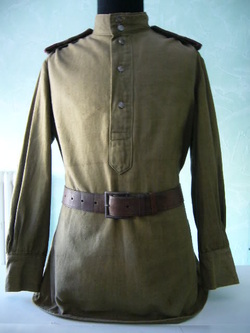
Important! The M43 gymnastiorka is the uniform item the Red Guard wears most so this is the first tunic you should buy! This style of tunic is based on a design dating back to the late 1800's with the Czarist Army. Like the earlier M-35 model, it was made in wool for the cold months and cotton for the summer months. Pocketless M-43 tunics made of proper Soviet cotton cloth are available from many vendors for usually less than $100 for the tunic itself. Originals can now go for as much as $500! Reputable vendors include Schuster, Hikishop, and Trident*.
Enlisted men may only wear the pocketless style tunic. Officer types with pockets are not accepted as the norm but can be tolerated until the correct version can be acquired. Women's tunics may have pockets. All tunics should have the white collar liner sewn in. It should be noted that collar liners are needed for both the M-35 and M-43 tunics and a Soviet soldier was expected to change his liner every morning though this seldom happened under combat conditions. The collar liner is said to be be a matchstick's width above the collar just showing a little bit of the white. The ends of the collar liner should not touch and have about an inch or so gap between ends. If you have questions, please ask.
Shoulder boards for M-43 tunics should be originals, early postwar, or well made repros from Red Guard Militaria (Our Kapitan Dorian Motowylak) or D.F. Smith Reproductions.
All rank stripes, medals, and other insignias must be earned and approved by your CO.
All tunics are required to have an original WW2 Guard's badge!!! POSTWAR BADGES ARE NOT ACCEPTED! We also accept the reproductions that Trident Militaria has for $20, but originals are still readily available on Ebay. It's very easy to tell a WW2 badge from a postwar one. See the "cheat sheet" below for tips on getting a good Guards Badge. Originals can be found on ebay.com usually for $30 to $100 depending on condition and seller etc.
A wide variety of buttons were used on these tunics but for enlisted men, the OD painted types (original or postwar) are preferred. These can be purchased from Trident Militaria or collectrussia.com. Collectrussia.com also has original war time 3-piece construction buttons for $7 each if you want to go that far. Sometimes you'll see entire lots of original buttons on eBay.
Shoulder boards must have the proper size 18 mm buttons, OD or brass. These can also be found only many sites like eBay, Trident and collectrussia.com. Period photos show a variety of buttons being used so be sure to study period photographs.
Enlisted men may only wear the pocketless style tunic. Officer types with pockets are not accepted as the norm but can be tolerated until the correct version can be acquired. Women's tunics may have pockets. All tunics should have the white collar liner sewn in. It should be noted that collar liners are needed for both the M-35 and M-43 tunics and a Soviet soldier was expected to change his liner every morning though this seldom happened under combat conditions. The collar liner is said to be be a matchstick's width above the collar just showing a little bit of the white. The ends of the collar liner should not touch and have about an inch or so gap between ends. If you have questions, please ask.
Shoulder boards for M-43 tunics should be originals, early postwar, or well made repros from Red Guard Militaria (Our Kapitan Dorian Motowylak) or D.F. Smith Reproductions.
All rank stripes, medals, and other insignias must be earned and approved by your CO.
All tunics are required to have an original WW2 Guard's badge!!! POSTWAR BADGES ARE NOT ACCEPTED! We also accept the reproductions that Trident Militaria has for $20, but originals are still readily available on Ebay. It's very easy to tell a WW2 badge from a postwar one. See the "cheat sheet" below for tips on getting a good Guards Badge. Originals can be found on ebay.com usually for $30 to $100 depending on condition and seller etc.
A wide variety of buttons were used on these tunics but for enlisted men, the OD painted types (original or postwar) are preferred. These can be purchased from Trident Militaria or collectrussia.com. Collectrussia.com also has original war time 3-piece construction buttons for $7 each if you want to go that far. Sometimes you'll see entire lots of original buttons on eBay.
Shoulder boards must have the proper size 18 mm buttons, OD or brass. These can also be found only many sites like eBay, Trident and collectrussia.com. Period photos show a variety of buttons being used so be sure to study period photographs.
M-35 TUNIC (Gymnastiorka)
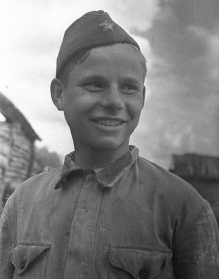
The M-35 IS NOT a required uniform article to get right away! As most Red Army events will be mid to late war, we seldom get to use the M-35 tunic. Trident Militaria, Hikishop, and Schuster make acceptable repros. In the future, we plan on hosting more early war events so we can all use our M-35 tunics so please put this item on your long term purchase list.
The collar insignia (petlitsii) on the M-35 tunic should be the subdued M-41 kind with the exception of NCOs & Officers, if rank pips are worn ( Jr. Sgt and up ) should be made of red enamel or OD painted. Brighter prewar collar tabs should be reserved for officers, NCOs, medics, etc...
Collar liners must be sewn into the collar. Collectrussia.com or frontofrussia.com are great places for collar liners or you can easily make one of your own.
The tunic is always worn un-tucked from the trousers unless being worn in the cold with an overcoat etc...
The collar insignia (petlitsii) on the M-35 tunic should be the subdued M-41 kind with the exception of NCOs & Officers, if rank pips are worn ( Jr. Sgt and up ) should be made of red enamel or OD painted. Brighter prewar collar tabs should be reserved for officers, NCOs, medics, etc...
Collar liners must be sewn into the collar. Collectrussia.com or frontofrussia.com are great places for collar liners or you can easily make one of your own.
The tunic is always worn un-tucked from the trousers unless being worn in the cold with an overcoat etc...
C. BREECHES (Sharovari)
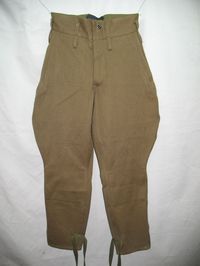
Many dealers offer both "M35" and "M43" breeches with the difference defined as suspender buttons vs belt loops. This is a misnomer. There was no official pattern change to breeches in 1943 so the differences are simply manufacturer variations. Both styles were worn throughout the war and were made of both cotton, wool, and even blends.
Original, postwar, and good repros are accepted. Acceptable repros are available from Schuster, Hikishop, and Trident*. Branch piping is only for officers or Sr. NCOs.
Photographic evidence suggests that it was not uncommon to have a slightly different color breeches from you tunic so don't be overly concerned about matching.
Original, postwar, and good repros are accepted. Acceptable repros are available from Schuster, Hikishop, and Trident*. Branch piping is only for officers or Sr. NCOs.
Photographic evidence suggests that it was not uncommon to have a slightly different color breeches from you tunic so don't be overly concerned about matching.
D. BOOTS (Sapogi and Botinki)
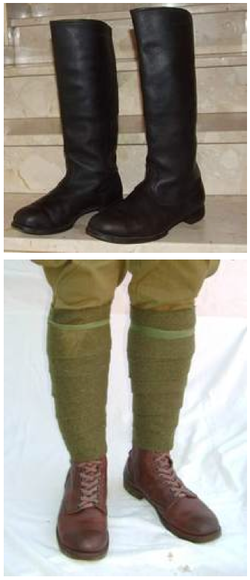
The Red Guard allows both high boots (Sapogi) and low boots (Botinki) with puttees (Obmotki).
If you can get Soviet high boots, please do! These were the preferred footwear for the Red Army for the majority of the war. Sapogi were similar in appearance to the German jackboot but were made of different materials. Where the German boots were made of leather, Red Army boots were conglomerate having rubberized canvas tops, leather vamps and heels, and rubber soles. This style of boot was the preferred footwear of the Red Army but they never entirely replaced low boots. As such, we also allow low boots w/ proper puttees/leggings. Over 12,000,000 pair of boots were provided to the Soviet Union by the western allies via Lend-Lease so British and American low boots are allowed as are Soviet and German low boots.
The best places to find Russian boots are eBay, Trident, and Russia Boots. We also allow East German jackboots until you can do better.
Period socks are allowed to be worn but portyanki footwraps are very strongly encouraged. These can be bought from collectrussia.com and Trident. If you must wear socks, at least get repro German ones or some sort of period home knit socks.
Soviet soldiers were known to keep their spoon tucked down inside their high boots at the side of the calf, handle facing down.
If you can get Soviet high boots, please do! These were the preferred footwear for the Red Army for the majority of the war. Sapogi were similar in appearance to the German jackboot but were made of different materials. Where the German boots were made of leather, Red Army boots were conglomerate having rubberized canvas tops, leather vamps and heels, and rubber soles. This style of boot was the preferred footwear of the Red Army but they never entirely replaced low boots. As such, we also allow low boots w/ proper puttees/leggings. Over 12,000,000 pair of boots were provided to the Soviet Union by the western allies via Lend-Lease so British and American low boots are allowed as are Soviet and German low boots.
The best places to find Russian boots are eBay, Trident, and Russia Boots. We also allow East German jackboots until you can do better.
Period socks are allowed to be worn but portyanki footwraps are very strongly encouraged. These can be bought from collectrussia.com and Trident. If you must wear socks, at least get repro German ones or some sort of period home knit socks.
Soviet soldiers were known to keep their spoon tucked down inside their high boots at the side of the calf, handle facing down.
E. UNDER CLOTHING
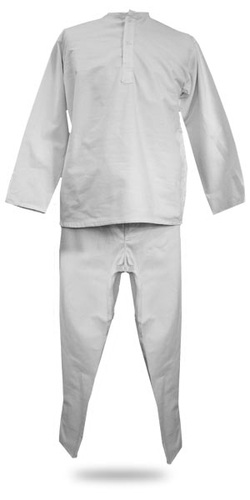
A must have! Original and postwar Soviet underwear is strongly encouraged. These can be found through many sites like collectrussia.com or eBay. These sets consist of a white shirt shaped a bit like the tunic and plain white under drawers.
NO BLUE STRIPED NAVAL INFANTRY UNDERSHIRTS OR TANK TOPS!!! Red Army infantry simply didn't wear
those. Don't let Hollywood fool you.
NO BLUE STRIPED NAVAL INFANTRY UNDERSHIRTS OR TANK TOPS!!! Red Army infantry simply didn't wear
those. Don't let Hollywood fool you.
*SPECIAL NOTE*
Wear your uniform with pride! For instance, if we all go into a town after an event to eat dinner, make sure you clean it up a bit. You never know who you will pass or sit beside. We could eat next to a real Soviet veteran or Russian so we WILL look sharp and uniformed. We will be soldiers on as well as off the battlefield. When off duty, belts will be worn in proper fashion. Nothing is to be worn on the belt when off duty. Straighten up your medals and badges. The uniform collar should be buttoned. Your boots should be shined up a bit if not all the way. Unless you are a female, all caps will be removed when entering a building. When in a group eating or walking in town, we will behave ourselves and act accordingly. We will have dignity when in uniform. The type of soldier you are off the battlefield will reflect upon what type of soldier you will be on the battlefield!
2. WINTER GEAR
A. PADDED WINTER CAP (Ushanka) -
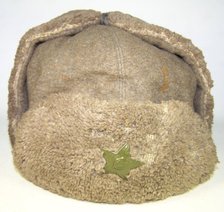
Along with the PPSh-41, the ushanka is one of the ubiquitous symbols of the Red Army Soldier in the Great Patriotic War. As such, original winter caps are prohibitively expensive. The good news is, there are some cheaper ways out.
Our Kapitan, Dorian Motowylak actually make proper reproductions using postwar Bulgarian and Soviet ushankas. Any questions, please contact him for prices or other info.
As with the pilotkas, only original/early postwar cap stars may be worn. Avoid reproduction cap stars.
Our Kapitan, Dorian Motowylak actually make proper reproductions using postwar Bulgarian and Soviet ushankas. Any questions, please contact him for prices or other info.
As with the pilotkas, only original/early postwar cap stars may be worn. Avoid reproduction cap stars.
B. PADDED JACKET (Telegrieka)
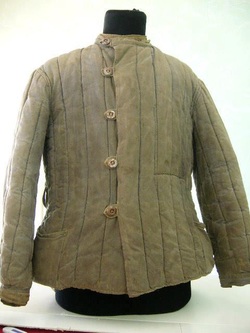
When the 13th Guards won fame at Stalingrad, the preferred coat in use was the telegrieka. Granted, the greatcoat (which we'll get into next ) was issued in far greater numbers, however, in an urban setting like Stalingrad, Warsaw, or Berlin, the padded coat is a bit easier to move around in and will not snag on things like the greatcoat would. It is prefered that every member have a matching set of telegrieka padded trousers for the coldest of events. Such a suit could save your life. If at all possible, we'd prefer for all members of the Red Guard to have both the telegrieka and greatcoat so we can switch up and all match accordingly like real Soviet Guards units would have. No insignia is to be worn on the padded jacket unless you are a senior NCO or officer. It was not uncommon to see Guards badges or other various medals pinned to the telegreika jacket. Check eBay for the best deals on padded suits.
Two types of telegreika are often sold. As with breeches, they are marketed as "early," with a fall-down collar, and "late" with a standing collar. While both versions served side by side throughout the war, we prefer the version with the standing collar to achieve a more uniform look.
Two types of telegreika are often sold. As with breeches, they are marketed as "early," with a fall-down collar, and "late" with a standing collar. While both versions served side by side throughout the war, we prefer the version with the standing collar to achieve a more uniform look.
C. GREATCOAT (Shinel)
This was by far the the most common winter coat worn by Red Army forces before, during, and after WW2. The greatcoat stayed in service with the Red Army all the way until 1991 when the USSR fell. Most postwar greatcoats are acceptable in the Red Guard as originals are extremely hard to find and expensive. Reproductions are just now making their way into the US but very slowly.
Special care must be taken to make the postwar coat look more WW2. All postwar buttons should be removed and replaced with original proper size 22 mm buttons (for rear "half" belt and collar tabs) and 18 mm (for shoulder boards). These can be found on collectrussia.com or often on eBay. All postwar insignia must be removed!!! As we rarely do early war events, the greatcoat must be set up with M-43 insignia. These can an be original, early postwar, or repro. Wartime photos suggest an odd match of insignia within some units. Some men had collar tabs and no shoulder boards, some had shoulder boards on the coat with no tabs. Some had buttons on the tabs, some didn't. In another photo, you may see a man with no insignia at all next to a man with full insignia including buttons on the collar tabs. There are even rare photos showing M-35 insignia being worn with shoulder boards. While all these scenarios occurred during the war, we are shooting for a typical look so full M-43 insignia are required.
Blankets were not issued to Soviet soldiers who were expected to make do with a greatcoat.* Therefore, every member of the unit will learn how to roll the greatcoat into a bedroll and will sometimes be required to carry it into the field over your left shoulder in the proper fashion. eBay is a great place to get a greatcoat in your size. Be sure to also pick up a Soviet bedroll/shelter half strap.
*We do allow blankets to be used in the field at cold events as a concession to safety. Period types are accepted along with "trophy" German types. These are to be kept in the myeshok pack.
Special care must be taken to make the postwar coat look more WW2. All postwar buttons should be removed and replaced with original proper size 22 mm buttons (for rear "half" belt and collar tabs) and 18 mm (for shoulder boards). These can be found on collectrussia.com or often on eBay. All postwar insignia must be removed!!! As we rarely do early war events, the greatcoat must be set up with M-43 insignia. These can an be original, early postwar, or repro. Wartime photos suggest an odd match of insignia within some units. Some men had collar tabs and no shoulder boards, some had shoulder boards on the coat with no tabs. Some had buttons on the tabs, some didn't. In another photo, you may see a man with no insignia at all next to a man with full insignia including buttons on the collar tabs. There are even rare photos showing M-35 insignia being worn with shoulder boards. While all these scenarios occurred during the war, we are shooting for a typical look so full M-43 insignia are required.
Blankets were not issued to Soviet soldiers who were expected to make do with a greatcoat.* Therefore, every member of the unit will learn how to roll the greatcoat into a bedroll and will sometimes be required to carry it into the field over your left shoulder in the proper fashion. eBay is a great place to get a greatcoat in your size. Be sure to also pick up a Soviet bedroll/shelter half strap.
*We do allow blankets to be used in the field at cold events as a concession to safety. Period types are accepted along with "trophy" German types. These are to be kept in the myeshok pack.
How to roll your greatcoat when not being worn. The roll should be worn over your left shoulder to keep your firing shoulder open.
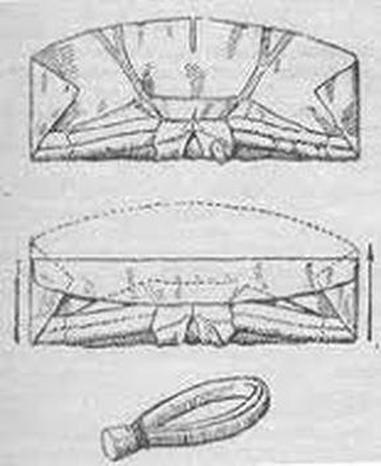
3. FIELD GEAR
A. WAIST BELT (Remyen)
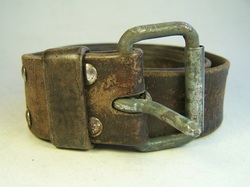
A variety of belts were worn by the Red Army soldiers of the Great Patriotic War. This section will describe three of the most common.
The most common waist belt of the Great Patriotic War was a leather belt with a iron roller buckle (see left). There were a terrific number of variations but nearly all such belts had the following features - an iron roller buckle, a fixed loop and a "floating" loop, and an extra long cut to accommodate a variety of body types and to allow the belt to worn over heavy winter clothing. Postwar Bulgarian belts are allowed as are belts made by our unit Starshina. Postwar Bulgarian belts are identical to wartime soviet all leather belts and are available on Shopbulgaria.com and eBay.
WW2 era US Garrison belts (below right) are also highly encouraged as thousands were sent to the USSR during the war via the Lend-Lease agreement. These belts frequently appear in period photos and are available on eBay and from our Kapitan from time to time.
Until recently, there was a shortage of correct leather waist belts. However, quality reproductions of the M1941 waist belt (below left) have been available. The M1941 belt was first introduced in the winter of 1941 during a period of shortages of leather. Due to these shortages, it was made of cotton webbing with leather reinforcements. These belts are available from Trident, Schuster, and Hikishop.
The most common waist belt of the Great Patriotic War was a leather belt with a iron roller buckle (see left). There were a terrific number of variations but nearly all such belts had the following features - an iron roller buckle, a fixed loop and a "floating" loop, and an extra long cut to accommodate a variety of body types and to allow the belt to worn over heavy winter clothing. Postwar Bulgarian belts are allowed as are belts made by our unit Starshina. Postwar Bulgarian belts are identical to wartime soviet all leather belts and are available on Shopbulgaria.com and eBay.
WW2 era US Garrison belts (below right) are also highly encouraged as thousands were sent to the USSR during the war via the Lend-Lease agreement. These belts frequently appear in period photos and are available on eBay and from our Kapitan from time to time.
Until recently, there was a shortage of correct leather waist belts. However, quality reproductions of the M1941 waist belt (below left) have been available. The M1941 belt was first introduced in the winter of 1941 during a period of shortages of leather. Due to these shortages, it was made of cotton webbing with leather reinforcements. These belts are available from Trident, Schuster, and Hikishop.
B. GAS MASK BAG (Soomka Protivogaznaya)
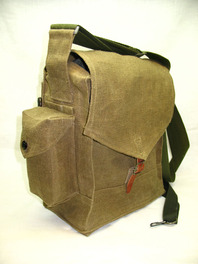
Like most Red Army equipment, a great variety of gas mask bags were available during the war. Color, material, number of pockets, how the sling adjusted, and how the flap buckled were all common variables. The bag pictured at left has external pockets for extra lenses and a decontamination kit. The bag at lower left lacks these pockets. These are common variations and bags like these served side-by-side.
The Red Guard allows original, early postwar, or well-made reproductions. While handy, this item is not needed right away as gas mask bags weren't being issued as much in the later years of the war. Repros can be found at Trident Militaria, Hikishop, and Red Guard Militaria.
It is not required that you have a gas mask for the bag. However, if you can get one for living histories and such, please do. Do the research and be sure to find a proper pre-war or wartime gas mask.
Note - The gas mask shoulder strap is not to be worn under the belt to hold it in place. The gas mask bag should have a waist strap just for this purpose. Also, the gas mask bag should be worn over the right shoulder hanging to your left. Examples of things to keep in your bag...extra ammo, food, cigarettes, drinking cup, spoon, candles, gloves etc...
The Red Guard allows original, early postwar, or well-made reproductions. While handy, this item is not needed right away as gas mask bags weren't being issued as much in the later years of the war. Repros can be found at Trident Militaria, Hikishop, and Red Guard Militaria.
It is not required that you have a gas mask for the bag. However, if you can get one for living histories and such, please do. Do the research and be sure to find a proper pre-war or wartime gas mask.
Note - The gas mask shoulder strap is not to be worn under the belt to hold it in place. The gas mask bag should have a waist strap just for this purpose. Also, the gas mask bag should be worn over the right shoulder hanging to your left. Examples of things to keep in your bag...extra ammo, food, cigarettes, drinking cup, spoon, candles, gloves etc...
C. RUCKSACK (Myeshok)
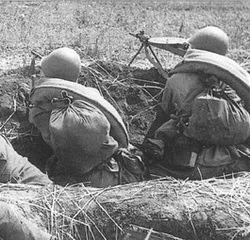
A must have for all periods of the war! The pack must be a WW2 original or early postwar version. No reproduction myeshoks or Bulgarian myeshok rucksacks will be allowed. There are plenty of postwar ones out there for under $50 each.The M-68 type with the blanket straps will not be allowed, even if they are converted! Your best source for this item is eBay.
Every member will know how to tie his/her own pack. Examples of things to put in your myeshok...blanket, plashe-palatka (shelter-half), food, mess kit, extra clothing etc...
Every member will know how to tie his/her own pack. Examples of things to put in your myeshok...blanket, plashe-palatka (shelter-half), food, mess kit, extra clothing etc...
D. AMMO POUCHES FOR MOSIN-NAGANT VARIANTS AND SVT-40.
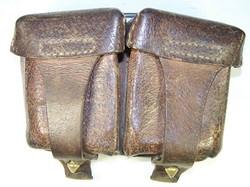
Only originals, early postwar, or reproduction pouches from Red Guard-approved vendors will be allowed. A great source for Mosin-Nagant ammunition pouches is eBay seller "kapterka". They offer "reparation" pouches made in East Germany immediately after the war to Soviet specifications. These are an excellent choice.
For reproductions, we only allow those made by Ostfront, Don Smith, and Dorian Motowylak. (Please note, only Dorian Motowylak is currently producing pouches. Ostfront and Don Smith pouches are only available on the secondary market.)
The vast majority of WW2 ammo pouches seem to have been made of all leather construction. We do allow the kirza M-44 pouches but only as loaners to new recruits at their first event. Basically, this means that by the time of your 2nd event, you should have a proper all leather construction 2-cell Mosin pouch!
Riflemen are only allowed to wear one pouch on your right side when carrying the Mosin-Nagant unless it's an early war event. SVT-40 riflemen are to only carry one pouch at all times with the spare cloth ammo pouch being optional. Wear the pouch right under your gun breech for easy loading. Early war "Czarist" types ammo pouches are only allowed for early war events.
Bandoleers will only be allowed in limited numbers. If you wish to wear a bandoleer, please consult the Kapitan or Starshina.
Y-Straps were made early in the war for the ammo belt and pouches but were discontinued at war's outbreak.
It must be stressed again that only one ammo pouch may be worn unless it's an early war event. Wearing two pouches at late war events is a far too common reenactorism and is not allowed in the Red Guard.
For reproductions, we only allow those made by Ostfront, Don Smith, and Dorian Motowylak. (Please note, only Dorian Motowylak is currently producing pouches. Ostfront and Don Smith pouches are only available on the secondary market.)
The vast majority of WW2 ammo pouches seem to have been made of all leather construction. We do allow the kirza M-44 pouches but only as loaners to new recruits at their first event. Basically, this means that by the time of your 2nd event, you should have a proper all leather construction 2-cell Mosin pouch!
Riflemen are only allowed to wear one pouch on your right side when carrying the Mosin-Nagant unless it's an early war event. SVT-40 riflemen are to only carry one pouch at all times with the spare cloth ammo pouch being optional. Wear the pouch right under your gun breech for easy loading. Early war "Czarist" types ammo pouches are only allowed for early war events.
Bandoleers will only be allowed in limited numbers. If you wish to wear a bandoleer, please consult the Kapitan or Starshina.
Y-Straps were made early in the war for the ammo belt and pouches but were discontinued at war's outbreak.
It must be stressed again that only one ammo pouch may be worn unless it's an early war event. Wearing two pouches at late war events is a far too common reenactorism and is not allowed in the Red Guard.
E. GRENADE POUCHES
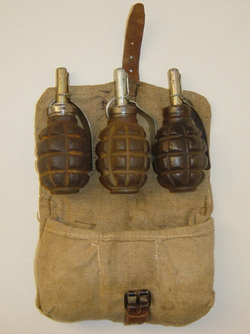
Grenade pouches are not very commonly issued items in the mid to late war years, but you may carry one if it's an original. The three-pocket type for carrying F-1 or RG-42 grenades are preferred. Postwar two-pocket types will not be accepted.
The pouch for the RGD-33 stick grenade is allowed but as these grenades are much harder to reproduce, these are not encouraged.
Original F-1 grenade pouches can be found on collectrussia.com and eBay and they come in a variety of colors and styles.
The pouch for the RGD-33 stick grenade is allowed but as these grenades are much harder to reproduce, these are not encouraged.
Original F-1 grenade pouches can be found on collectrussia.com and eBay and they come in a variety of colors and styles.
F. ENTRENCHING TOOL & CARRIER (Lopata and Soomka Lopata)
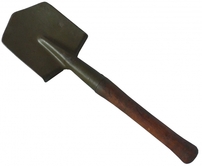
The lopata should be wartime or postwar Red Army construction and the carrier should be the half-cover type which photographic evidence suggests was the most common of the war. Our Kapitan makes these carriers that look great and are made from Soviet materials.
The lopata should be worn to the right side of the belt just to the right of your ammo pouches. This makes for easy access as well as tucking it into your belt. Also, at no time should the e tool hang behind you, always keep it along side your hip to prevent falling on it. In urban combat, trench fighting, or hand-to-hand combat, it was not uncommon to see the lopata tucked into the ammo belt to be used as a weapon. Also, original photos show lopatas hanging off of the backs of myeshok rucksacks tied by the U-strap and sometimes stuffed down in them with the handle poking out the top. So really, you don't need an e tool carrier as long as you have a pack or an ammo belt.
The lopata should be worn to the right side of the belt just to the right of your ammo pouches. This makes for easy access as well as tucking it into your belt. Also, at no time should the e tool hang behind you, always keep it along side your hip to prevent falling on it. In urban combat, trench fighting, or hand-to-hand combat, it was not uncommon to see the lopata tucked into the ammo belt to be used as a weapon. Also, original photos show lopatas hanging off of the backs of myeshok rucksacks tied by the U-strap and sometimes stuffed down in them with the handle poking out the top. So really, you don't need an e tool carrier as long as you have a pack or an ammo belt.
G. CANTEEN (Flyaga) & COVER
All postwar and original canteens and covers will be accepted. Wartime canteen have finer threads for the screw cap often have a rounder profile but these canteens are getting very difficult to find so we accept the postwar types.
As you can see in the picture below, canteen covers were made in a variety of colors. All canteen covers must have a black metal button or wooden toggle to keep it closed. Postwar plastic buttons must be removed and replaced. Wartime glass canteens are accepted but discouraged since they can break in combat.
It wasn't uncommon to see originals canteens engraved with patriotic slogans and trench art.
As you can see in the picture below, canteen covers were made in a variety of colors. All canteen covers must have a black metal button or wooden toggle to keep it closed. Postwar plastic buttons must be removed and replaced. Wartime glass canteens are accepted but discouraged since they can break in combat.
It wasn't uncommon to see originals canteens engraved with patriotic slogans and trench art.
H. SHELTER HALF/ RAIN CAPE (Plashe Palatka)
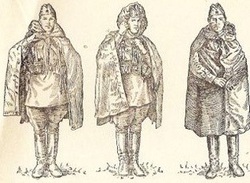
Another must have! These were very popular with troops during the entire war. One can easily see why as they had so many uses. As you may know, two or more can be buttoned together to form a tent. One can be worn as a poncho to keep you dry. Troops would often wear these into battle or on patrols as it would help break up the outline of the body. These can be found from many places like Hessenantique.com and eBay. Please, make sure your plashe or plashes have leather grommets at the four corners where the stakes would go. Metal grommets are not allowed as they date to the 1960s or later.
When weather is good and dry, the plashe can be used as a ground cloth to lay upon. When moving out into the field, the plashe must always be carried either over the shoulder in a bedroll or in the myeshok backpack. It seems as if it was preferred to wear it as a bedroll for easy access in case of rain. Proper tie straps can be bought for these and greatcoats from Ostfront.com or you may use "captured" German equipment straps or hemp rope.
When weather is good and dry, the plashe can be used as a ground cloth to lay upon. When moving out into the field, the plashe must always be carried either over the shoulder in a bedroll or in the myeshok backpack. It seems as if it was preferred to wear it as a bedroll for easy access in case of rain. Proper tie straps can be bought for these and greatcoats from Ostfront.com or you may use "captured" German equipment straps or hemp rope.
How the shelter half can be used -
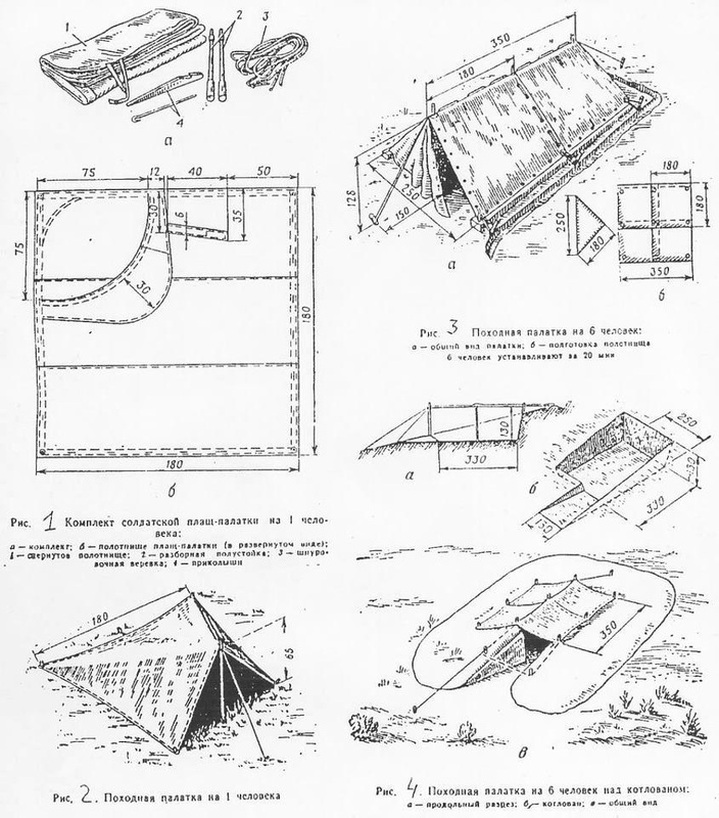
I. MESS KITS - "Kidney" style or Pail style (Koteluk)
Both forms of WW2 Soviet mess kit are accepted. The pail/bucket type are currently difficult to come by but do appear on eBay from time to time. While the pail style was more common, the "kidney" style was more popular with troops as it could close and store food better. "Captured" German mess kits are also accepted as many Soviet troops preferred them to their own pot style.
It was popular with troops to hang mess kits at the end of the greatcoat/plashe shelter half bedroll and from the myeshok backpack for easy access. When going into action, it's suggested to store your kit in your myeshok to keep it from making any type of noise. Always clean your mess kit after every time you use it. It was also popular for troops to decorate their mess kits with trench art.
Early in the war, mess kits were issued with cotton cloth covers designed to attach to the belt or rucksack but these were quickly discontinued at the war's outbreak. The Red Army also had bread/ration bags but these were also discontinued at the war's outbreak. These two items are not required even for early war scenarios.
It was popular with troops to hang mess kits at the end of the greatcoat/plashe shelter half bedroll and from the myeshok backpack for easy access. When going into action, it's suggested to store your kit in your myeshok to keep it from making any type of noise. Always clean your mess kit after every time you use it. It was also popular for troops to decorate their mess kits with trench art.
Early in the war, mess kits were issued with cotton cloth covers designed to attach to the belt or rucksack but these were quickly discontinued at the war's outbreak. The Red Army also had bread/ration bags but these were also discontinued at the war's outbreak. These two items are not required even for early war scenarios.
J. MOSIN-NAGANT & SVT-40 TOKAREV BAYONET (Shtik)
All riflemen except for snipers are required to have a bayonet and carry it in the reverse-unfixed position on your rifle like they did (if you use the Mosin-Nagant 91/30 model) into the field unless otherwise ordered by your CO to remove them. Of course, the bayonet will not be "fixed" in battle! If you have questions about this practice, please let your CO know. Mosin-Nagant bayonets can be found in many places where Soviet militaria is sold. eBay and collectrussia.com are great places to find them for a good price.
Mosin-Nagant bayonet scabbards will not be allowed as they just weren't common issue. NO RUBBER BAYONETS!!!
If you have an SVT-40/Tokarev rifle, it's not required but suggested you get a bayonet for it. They are highly priced but well worth it to fill out your impression.
* The bayonet is also an all purpose tool. If a round gets stuck in your rifle, the bayonet can be removed to eject it. The end of your Nagant bayonet can also be used as a screw driver where need be. These can also be used as candle holders, tent pegs, etc. As it's possible to lose the bayonet in battle, make sure it's a tight fit on the rifle before going out in the field. Be sure the bayonet can work on the rifle in the fixed position for drill duties, living histories etc...
Mosin-Nagant bayonet scabbards will not be allowed as they just weren't common issue. NO RUBBER BAYONETS!!!
If you have an SVT-40/Tokarev rifle, it's not required but suggested you get a bayonet for it. They are highly priced but well worth it to fill out your impression.
* The bayonet is also an all purpose tool. If a round gets stuck in your rifle, the bayonet can be removed to eject it. The end of your Nagant bayonet can also be used as a screw driver where need be. These can also be used as candle holders, tent pegs, etc. As it's possible to lose the bayonet in battle, make sure it's a tight fit on the rifle before going out in the field. Be sure the bayonet can work on the rifle in the fixed position for drill duties, living histories etc...
K. SSh-40 and SSh-39 HELMETS (Stalshlem)
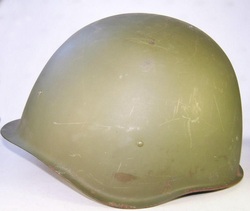
The SSh-39 was introduced in 1939 and was supposed to replace the earlier M-36. However, the liner of the SSh-39 proved to be unsatisfactory so a new suspension design was tested and approved. The improved helmet was designated the SSh-40.
The preferred helmet of the Red Guard is the SSh-40. All original and unmodified wartime pattern SSh-40 helmets will be accepted. All helmets must have a green or tan web chin strap and the three-pad liner in black or brown. No leather chinstraps! Soviet helmets come in only 3 sizes which are 1, 2 and 3 smallest to largest. Online, eBay Hessen Antique are good places to find correct SSh-40 helmets.
The SSh-39 helmet is accepted but should primarily be used for early war scenarios. No Czech, Polish, or Hungarian helmets are allowed unless properly "converted" into an SSh-39 or SSh-40. (Questions on the conversion process can be directed to your CO.) All members should get a proper SSh-40 as soon as possible.
Helmets are required for all participants at some events like Newville, PA and Lugoff, SC so all members should buy one as soon as you can. All members except for scouts and snipers are always required to wear a helmet at all Red Guard events unless otherwise ordered by the CO to remove them. No patriotic slogans may be applied the helmet as this was not a common wartime practice. No red stars on SSh-40 helmets.
It was common practice to wear the pilotka side cap under the helmet to help keep the helmet still. It is also common to see Red Army soldiers wearing the helmet's chin strap on the helmet visor in period photos. Wartime photos seldom show evidence that netting or any other type of camo or camo holder was used during the war so this not allowed. However, you may get your helmet as dirty and muddy as you like within reason.
M-36 helmets are often prohibitively expensive and are not a required item. They are allowed only for early war events!
The preferred helmet of the Red Guard is the SSh-40. All original and unmodified wartime pattern SSh-40 helmets will be accepted. All helmets must have a green or tan web chin strap and the three-pad liner in black or brown. No leather chinstraps! Soviet helmets come in only 3 sizes which are 1, 2 and 3 smallest to largest. Online, eBay Hessen Antique are good places to find correct SSh-40 helmets.
The SSh-39 helmet is accepted but should primarily be used for early war scenarios. No Czech, Polish, or Hungarian helmets are allowed unless properly "converted" into an SSh-39 or SSh-40. (Questions on the conversion process can be directed to your CO.) All members should get a proper SSh-40 as soon as possible.
Helmets are required for all participants at some events like Newville, PA and Lugoff, SC so all members should buy one as soon as you can. All members except for scouts and snipers are always required to wear a helmet at all Red Guard events unless otherwise ordered by the CO to remove them. No patriotic slogans may be applied the helmet as this was not a common wartime practice. No red stars on SSh-40 helmets.
It was common practice to wear the pilotka side cap under the helmet to help keep the helmet still. It is also common to see Red Army soldiers wearing the helmet's chin strap on the helmet visor in period photos. Wartime photos seldom show evidence that netting or any other type of camo or camo holder was used during the war so this not allowed. However, you may get your helmet as dirty and muddy as you like within reason.
M-36 helmets are often prohibitively expensive and are not a required item. They are allowed only for early war events!
L. CAPTURED GERMAN FIELD GEAR
There may be a few exceptions here as far as captured tools like binoculars, entrenching tools, pencils, watches, mess kits, flashlights, etc... No German bread bags or canteens please! You may wear captured German belts provided they have been defaced with trench art.
M. FLASHLIGHTS
Flashlights are allowed in limited numbers but are mainly for use by officers, NCOs, and specialists. If you bring one, it must be of a period correct Soviet or "captured" German pattern. Of course, light discipline will be maintained at all times during nighttime scenarios. During the day,the flashlight should be kept inside the pack.
N. MISC. ITEMS
- Map cases may be carried by Officers or Sr. NCOs only. No postwar types please.
- Binoculars will only be worn by Officers, NCOs, scouts, or snipers.
- Scout knives may only be worn by snipers or scouts. Period type pocket knives may be carried by all ranks and specialties.
- Camouflage items must be approved by the CO. The amoeba pattern seems to have been most common and may only be worn by scouts, engineers, or snipers.
- Wristwatches or pocket watches must be also be of the proper period.
- Spoons can be either wood or metal but must be of 1930s/40s European style.
O. POCKET & PERSONAL ITEMS
Little things really make your impression! As we strive to be a living history unit as well as a tactical unit, small personal items are highly encouraged. Please take the time to gather little things for your impression. This will bring you closer to the soldier you are trying to portray. Such items could be a sewing kit, tobacco pouch, lighter and/or matches, period cigarettes, period toothbrush, straight razor, period "family" photos, an ID booklet personalized to you, newspapers, a period pencil and paper, period money, food packaging, spoon, spare buttons, pocket knife, gun cleaning kit, period postcards or letters, etc... The list could go on and on. Remember, the more you put into your impression is the more you get out of it! Collectrussia.com, eBay, and aboutww2militaria.com are 3 good places to find small personal items.
3. WEAPONS
A. MOSIN-NAGANT MODEL 91/30
This was the primary weapon of the Red Army infantry. When you take the field, please be sure to have a proper cleaning kit, bayonet, and a Soviet webbing sling. No all-leather slings!
No Finnish-made variants or captures!
Your rifle should be dated from the 30s to the mid 40s. Most were made during these years so it shouldn't be hard to find one at a good price. Try gunbroker.com, auctionarms.com, or militarygunsupply.com for these rifles. Your local gun show is the best place to find one.
Remember, the bayonet was always fixed and very rarely issued with a scabbard. (See bayonets section above for more info.) NO RUBBER BAYONETS!
If you do a sniper impression, you are NOT allowed to wrap your scope or barrel in burlap cloth strips etc... This is seldom if ever seen in period photos and generally seems to be a common reenactor-ism thanks to the film "Enemy at the Gates."
B. SVT-40 TOKAREV SELF-LOADING RIFLE
SVT-40s are allowed but, as with the Mosin-Nagant, to be carried in the field, you must have proper sling, bayonet, tools, and accoutrements.
AVT-36s and SVT-38s are also allowed in the ranks for early to mid-war events.
AVT-36s and SVT-38s are also allowed in the ranks for early to mid-war events.
C. M-38 and M-44 CARBINE
The M-38 carbine should usually only be carried by cavalry, engineers, traffic controllers, and heavy weapon crews.
The M-44 carbine is easily distinguished from the M-38 by its side-folding bayonet. M-44 carbine production actually started in late 1943 but these handy weapons were very late arriving on the battlefield. As such, they are not ideal as your main weapon but are allowed for very late war scenarios.
The M-44 carbine is easily distinguished from the M-38 by its side-folding bayonet. M-44 carbine production actually started in late 1943 but these handy weapons were very late arriving on the battlefield. As such, they are not ideal as your main weapon but are allowed for very late war scenarios.
D. PPSH-41
Along with the T-34 tank, the PPSh-41 is THE symbol of the Red Army in the Great Patriotic War. Select-fire or semi-auto only guns are allowed. However, PPSh-41s with a 16-inch barrel are not allowed in the Red Guard. If you have one, there are ways to legally reduce the size of the barrel. One should contact the BATFE on this matter.
The best option is blank-only PPSh-41 offered by Indianapolis Ordnance. These are selective-fire and fire from an open bolt like the originals but can only fire blanks.
The best option is blank-only PPSh-41 offered by Indianapolis Ordnance. These are selective-fire and fire from an open bolt like the originals but can only fire blanks.
E. PPS-43
The PPS-43 is considered by many to be the best all-around submachine gun of WWII.
Since we do mostly late war events, these are highly encouraged. A Polish-made model is available from Centerfire Systems and an American-made model is available from Smith Machine Group. Because these new reproductions are semi-automatic and the folding stock is fixed in the closed position, it is legally considered a pistol by the BATFE.
Also, a blank-only version is available from Indianapolis Ordnance. These are full-automatic and fire from an open bolt like the originals but can only fire blanks.
PPS-43s are only allowed for mid-1943 or later events.
Since we do mostly late war events, these are highly encouraged. A Polish-made model is available from Centerfire Systems and an American-made model is available from Smith Machine Group. Because these new reproductions are semi-automatic and the folding stock is fixed in the closed position, it is legally considered a pistol by the BATFE.
Also, a blank-only version is available from Indianapolis Ordnance. These are full-automatic and fire from an open bolt like the originals but can only fire blanks.
PPS-43s are only allowed for mid-1943 or later events.
F. PISTOLS (NAGANT REVOLVER & TT33)
Only officers and medics are allowed to carry sidearms. However, enlisted men may carry "captured" German pistols but they must be hidden away as enlisted men were usually never allowed to carry any sidearms what-so-ever.
G. DP-28
Wonderful if you can get one! Militarygunsupply.com now offers a DP-28 semi-auto version I would suggest looking into. These same guns can be found on gunbroker.com. The DP must have all the proper tools, ammo cases, mags etc... DT light machine guns modified for infantry use are allowed however DPMs are not.
H. 1910 MAXIM OR SG-43 HEAVY MACHINE GUN
Like the DP, it must come with all the proper gear. The SG-43 may only be used at mid to late late events. Semi auto versions of each gun can sometimes be found at gunbroker.com where they can go for up to $5,000.
I. 50mm MORTAR
A one man carried mortar for a two-man team and highly encouraged to purchase if you are interested in a support weapons impression. These can be found from time to time on gunbroker.com
J. 82mm MORTAR
Super heavy, but very effective. On the march, the mortar was carried in three sections by a four man crew. The unit has members who can teach you to make rounds for them or the 50mm mortar. Like the 50mm, examples can also be found on gunbroker.com
K. ANTI-TANK RIFLES & CANNONS
Sure, get one if you can, good luck! Both are on gunbroker.com from time to time for $3,000 and up.
L. CAPTURED GERMAN/ OTHER AXIS & LEND LEASE WEAPONS
Only the MG-34, MG-42, MP-38 and MP-40 will be allowed as the Soviets did indeed use them in quantity.
